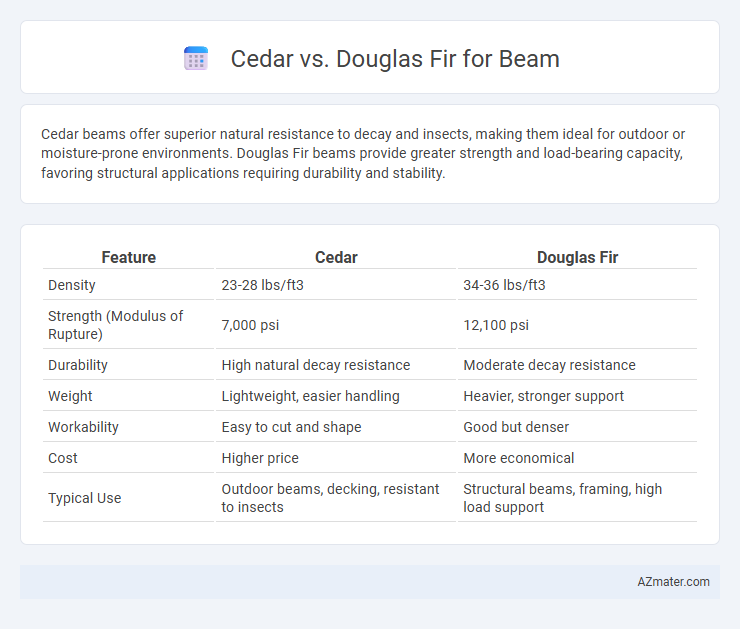Cedar beams offer superior natural resistance to decay and insects, making them ideal for outdoor or moisture-prone environments. Douglas Fir beams provide greater strength and load-bearing capacity, favoring structural applications requiring durability and stability.
Table of Comparison
| Feature | Cedar | Douglas Fir |
|---|---|---|
| Density | 23-28 lbs/ft3 | 34-36 lbs/ft3 |
| Strength (Modulus of Rupture) | 7,000 psi | 12,100 psi |
| Durability | High natural decay resistance | Moderate decay resistance |
| Weight | Lightweight, easier handling | Heavier, stronger support |
| Workability | Easy to cut and shape | Good but denser |
| Cost | Higher price | More economical |
| Typical Use | Outdoor beams, decking, resistant to insects | Structural beams, framing, high load support |
Introduction: Choosing Between Cedar and Douglas Fir for Beams
Cedar and Douglas Fir are popular choices for beams due to their strength and durability, with Cedar offering natural resistance to decay and insects, making it ideal for outdoor or moisture-prone applications. Douglas Fir boasts superior load-bearing capacity and straight grain, providing structural stability in heavy construction projects. Selecting the right wood depends on environmental exposure, load requirements, and aesthetic preferences, with Cedar excelling in longevity and Douglas Fir in strength.
Overview of Cedar Wood for Beam Applications
Cedar wood offers exceptional durability and natural resistance to decay and insects, making it an ideal choice for beam applications exposed to moisture. Its lightweight yet strong structure provides excellent load-bearing capacity while reducing structural weight compared to heavier hardwoods. The warm, reddish hue and fine grain of cedar enhance aesthetic appeal, contributing both functional and visual benefits to construction projects.
Overview of Douglas Fir for Beam Applications
Douglas Fir is highly valued for beam applications due to its exceptional strength-to-weight ratio and dimensional stability. Its straight grain and high resistance to warping and twisting make it ideal for long, load-bearing beams in construction. This species also offers superior durability and compatibility with various coatings, ensuring longevity in structural frameworks.
Strength and Structural Performance Comparison
Douglas Fir exhibits superior strength and structural performance compared to Cedar, making it a preferred choice for load-bearing beams and heavy construction. With a higher modulus of elasticity and greater compressive strength, Douglas Fir supports larger spans and heavier loads without excessive deflection. Cedar, while lighter and more resistant to decay, offers lower structural capacity, which limits its use primarily to decorative or light framing applications.
Durability and Weather Resistance
Douglas Fir beams exhibit superior durability and weather resistance compared to Cedar, thanks to their dense grain structure that withstands heavy loads and resists warping over time. Cedar offers natural decay resistance and contains oils that deter insects and moisture damage, making it favorable for outdoor use but generally less robust under prolonged structural stress. For heavy-duty beam applications exposed to harsh weather, Douglas Fir is typically preferred due to its strength and longevity.
Appearance and Aesthetic Differences
Cedar beams offer rich reddish tones with fine, straight grain patterns that provide a warm, rustic appeal, while Douglas Fir beams feature a lighter, golden hue with more pronounced growth rings and knots, creating a striking, natural texture. Cedar's natural oils give it a smooth, satiny finish that enhances its visual depth, whereas Douglas Fir tends to have a more rugged and robust aesthetic, often favored in industrial or farmhouse styles. Choosing between Cedar and Douglas Fir for beams depends on whether the desired look is softer and more refined or bold and textured.
Workability and Ease of Installation
Cedar beams offer superior workability due to their lightweight nature and soft grain, making them easier to saw, nail, and drill compared to Douglas Fir. Douglas Fir, although denser and stronger, requires more effort to cut and shape but provides excellent structural support, especially for heavy loads. Both woods install well with standard tools, but cedar's ease of handling reduces labor time, making it advantageous for quick installation projects.
Cost and Availability Factors
Douglas Fir beams generally offer a lower cost compared to Cedar due to their widespread availability and faster growth rates, making them an economical choice for construction projects. Cedar beams, while more expensive, provide natural resistance to decay and insect damage, but their limited regional availability can increase both cost and lead time. The choice between the two often hinges on budget constraints and local timber supply, with Douglas Fir favored for cost-efficiency and Cedar chosen for durability in outdoor or moisture-prone environments.
Best Use Cases for Cedar Beams vs. Douglas Fir Beams
Cedar beams excel in outdoor and moisture-prone environments due to their natural resistance to decay, insects, and rot, making them ideal for pergolas, decks, and exterior exposed structures. Douglas fir beams offer superior strength and dimensional stability, making them the preferred choice for heavy-load bearing applications like large-span roof beams and structural framing in residential and commercial construction. For aesthetic purposes, cedar provides a warm reddish hue with a fine grain, while Douglas fir showcases a lighter color with prominent grain patterns suited for exposed interior beams and architectural features.
Conclusion: Which Wood is Better for Your Beam Project?
Cedar offers superior natural decay resistance and a lighter weight, making it ideal for outdoor beam projects exposed to moisture. Douglas Fir provides greater structural strength and durability, suitable for heavy load-bearing interior or exterior beams. Choosing between Cedar and Douglas Fir depends on project requirements: opt for Cedar if longevity and resistance to rot are priorities, and Douglas Fir for maximum strength and support.

Infographic: Cedar vs Douglas Fir for Beam
 azmater.com
azmater.com